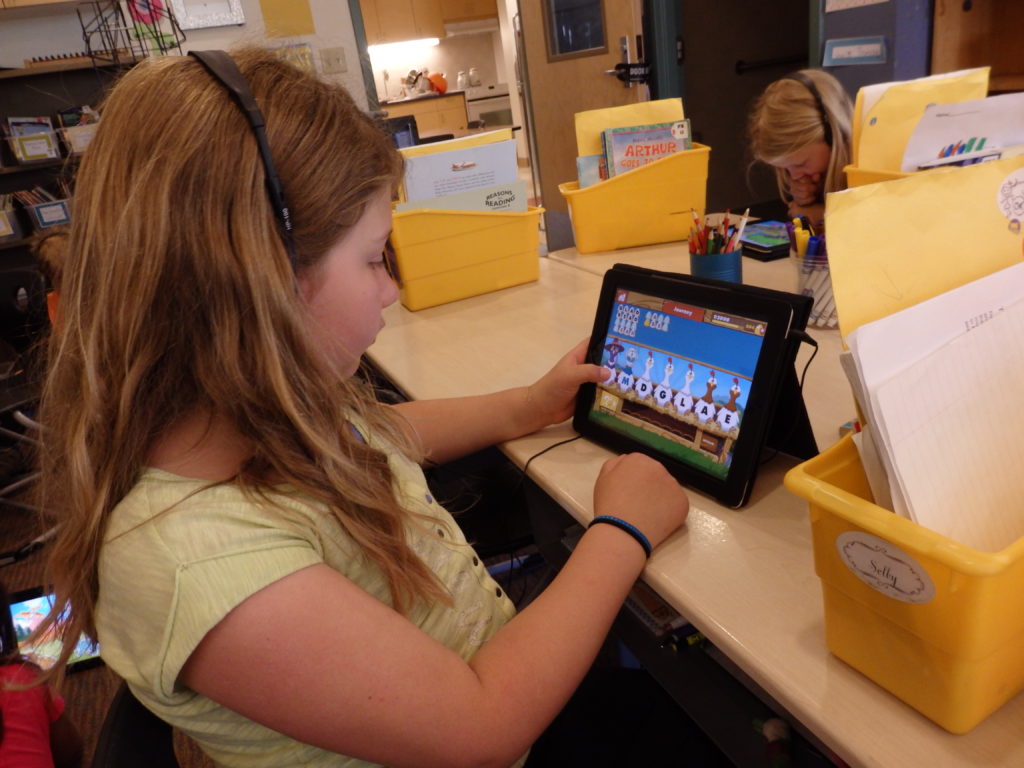Should every child at Haines School have their own laptop or iPad? That’s a question the Haines school district, school board, and community has struggled with over the past few months. At a meeting Tuesday, the school board made a final decision on the technology initiative. It approved $96,000 to expand laptops one-to-one in grades five and up.
“My iPad is number 14. I’m using this app called Chicktionary, and it helps you with spelling. So it’s a fun way to learn spelling,” said second grader Selby Long.
Selby says she thinks learning on the iPad is sometimes better than using a pencil and paper.
“Because some kids, they’re really tired and they don’t really want to do their math lesson. So on the iPads they make the math, they do fun things for the math, and then they hardly realize they’re doing work because it’s fun.”
What Selby is saying is iPads can help engage kids in learning. And that’s the goal the school district put forward. They dubbed the one-to-one technology initiative ‘Engaging the Future.’
“We have students who are disengaged, we have students who don’t see any relevance in school,” said Superintendent Ginger Jewell at a town hall meeting in May. “Because sometimes they come to a school that is so disconnected from the reality they see the other 17 hours of the day when they’re not in school, that they end up counting the days until they can do something else.”
But at that same meeting, members of the public spoke out against more technology. Especially for kids like Selby – in the younger grades. Suzanne Vuillet-Smith said technology takes away from human interactions.
“Interpersonal communication in the younger grades is more important than technology,” she said.
Dr. Adam McMahon said screen time can have a serious impact on developing brains.
“To take such a plastic mind and add another barrier for social contact, interaction and emotional learning — it’s not something that’s I’m comfortable with,” he said.
Haines second grade teacher Kim Sundberg was at that meeting.
“I felt a little bit like [the parents who spoke out] were out of touch with how we were using technology and all the other aspects of the hard work that goes into making sure kids are out on field trips, doing hands on learning,” Sundberg said.
Community members and some school board members were most concerned about technology in the younger grades. But it was the teachers in those grades who were the most outspoken at public meetings in favor of increasing technology.
“There is something where, when you’re a parent you know your child, and sometimes you see the world with just your child and you say, ‘my child doesn’t need that,'” said first grade teacher Sophia Armstrong. “But I see all these children, and there is times when I have to go this child needs this, this child needs this, this child needs this. And if it was all paper and pencil all the time it’s very hard to meet all those needs.”
Armstrong’s classroom shares iPads with Sundberg’s classroom. Both teachers said that limits their ability to use technology in the most useful ways. School board member Mike Wilson referred to the teachers’ concerns at Tuesday’s meeting.
“I want to go back to that part about trusting teachers, and what they have said and what they suggested,” Wilson said. “And I think they gave it a lot of thought. I think you will never replace a teacher with technology, but you will certainly enhance instruction.”
Board member Tiffany Dewitt said, the teachers might be in support of this, but most of the parents she’s talked to aren’t. She said she is not supportive of expanding technology in grades K-2.
Board member Sarah Swinton said she’d like to see a more gradual expansion of technology.
“I just want to reiterate the fiscal responsibility that we have and saving some screen time for our younger children,” she said.
Here’s the proposal the board had before them: $96,000 would buy 60 laptops and six digital whiteboards – called SMARTboards. It would bring the ratio of laptops to students one-to-one in grades 5-8. High schoolers already have one-to-one.
Students in grades four and under will have more technology, but they’ll still have to share. Grades three and four would share a cart of laptops and a cart of iPads. And Kindergarten, first, and second grades would share two iPad carts.
“I mean, I’m in support of the full initiative — to really give this initiative every opportunity to succeed,” said school board president Anne Marie Palmieri.
The board approved the $96,000 expenditure in a 5-2 vote. Brian Clay and Sarah Swinton voted against it. The money will come out of the district’s 880 fund for facilities and equipment, not the general fund. The district is also hiring a grant-funded technology specialist starting next year, who will work with teachers on how to effectively use this expanded technology.
At the end of the meeting, Palmieri reflected on how the one-to-one initiative went over.
“In retrospect, we could have put some different information out to the public,” she said. “We could’ve tried to educate our parents more about how it would look and how it would affect their children.”
This is Superintendent Jewell’s first school year with the Haines district. She says expanding technology one-to-one through the whole school seemed like a logical step to her, and she did not anticipate the concerns that came from the community.
But, Jewell says, she’s excited about the decision the board made, and she thinks the teachers will make the right choices about how to use technology in their classrooms.










